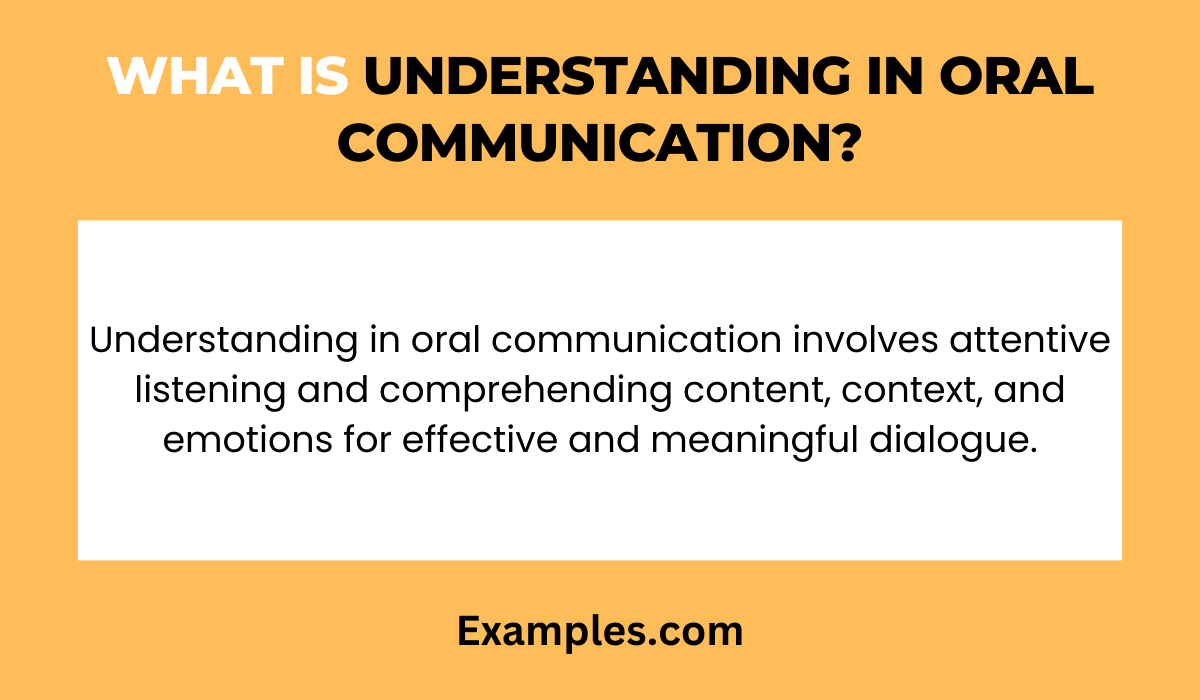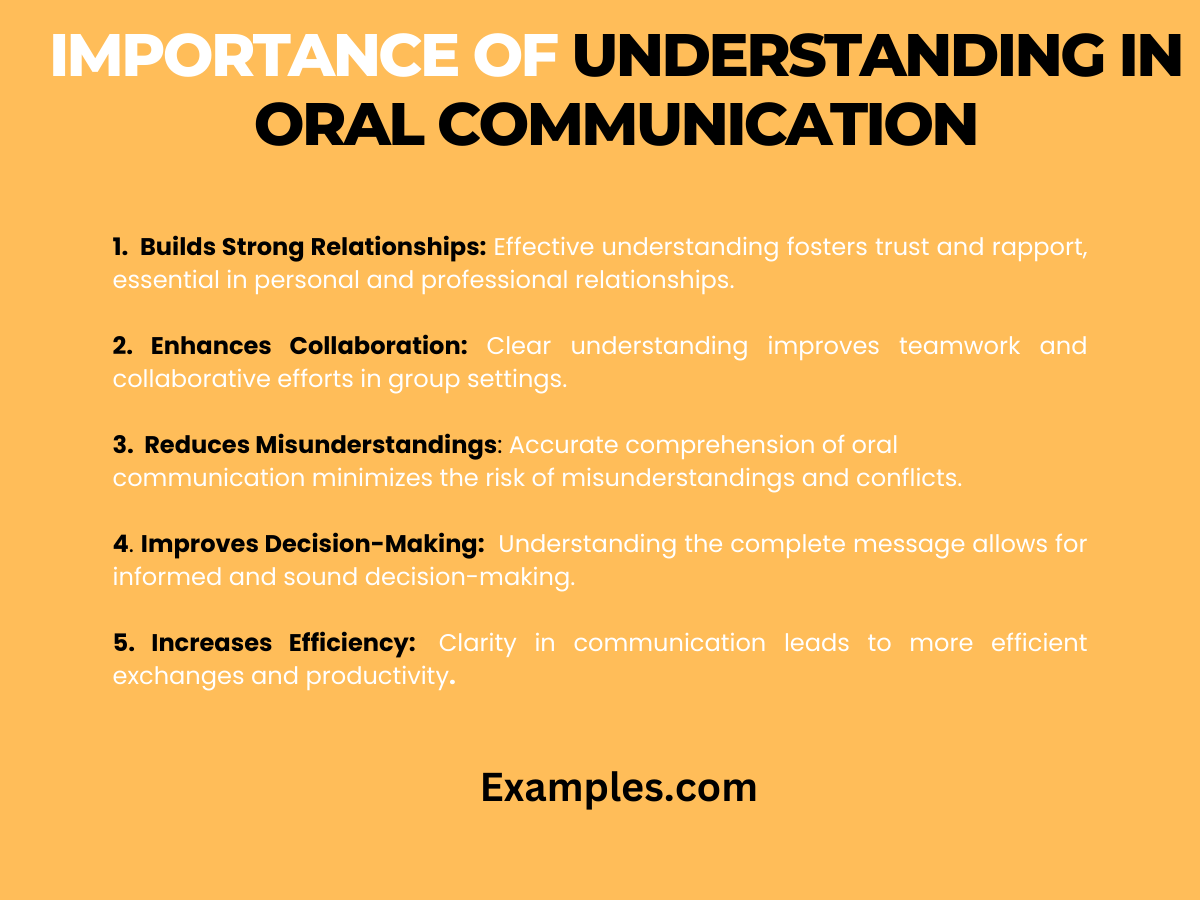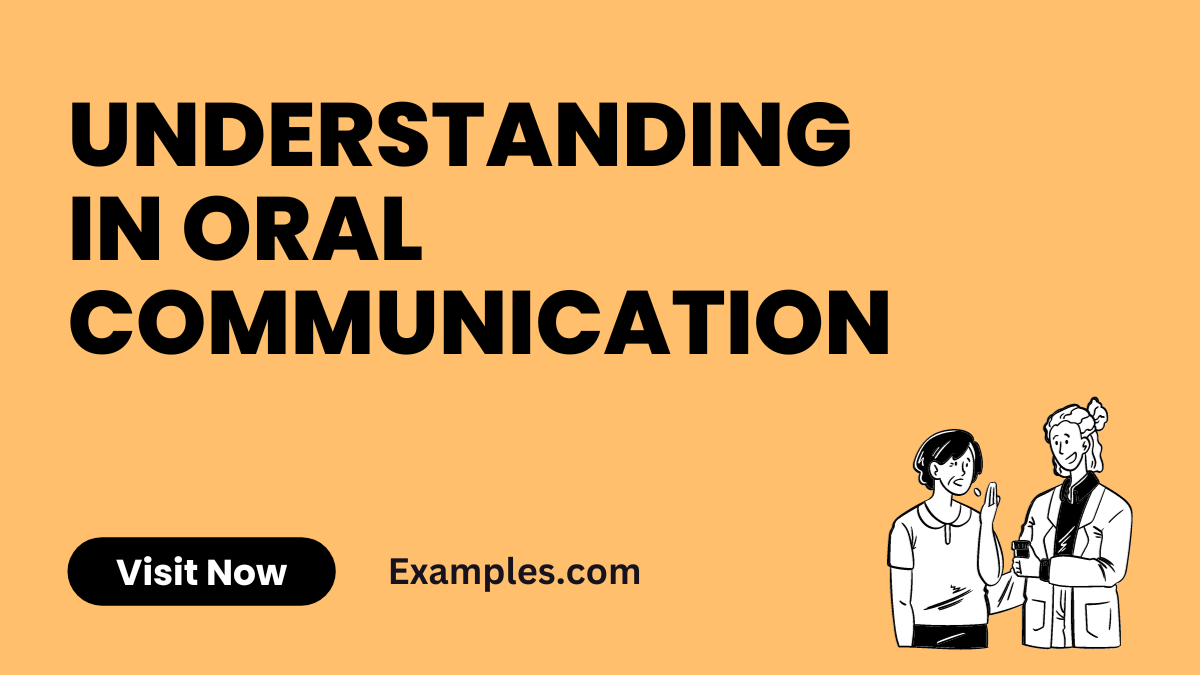Understanding in Oral Communication – Examples, Tips
Understanding in oral communication is pivotal for effective interactions. This comprehensive guide illuminates the art of conveying and interpreting messages, emphasizing the importance of active listening in oral communication and knowing your audience in oral communication. It delves into various communication examples, offering insights into different techniques that enhance clarity and engagement. Whether in personal conversations, business meetings, or public speaking, this guide provides valuable tips and strategies to improve your communication skills, ensuring your message is not just heard but also understood.
What is Understanding in Oral Communication?

Understanding in oral communication refers to the ability to accurately interpret and respond to spoken messages. It involves more than just hearing words; it requires attentiveness, comprehension of the content, context, and emotions conveyed. This skill is fundamental in all forms of dialogue, enabling meaningful and effective exchanges. Understanding in oral communication hinges on active listening, empathy, and the ability to discern subtleties in tone and context. It’s a dynamic process that enhances personal and professional relationships by fostering clarity, reducing misunderstandings, and strengthening connections.
How does Understanding Work in Oral Communication?
Understanding in oral communication is a multifaceted process that involves both the speaker and the listener. Here are 10 key points detailing how understanding works:
- Active Listening: Essential for comprehension, active listening involves fully concentrating on what is being said rather than just passively ‘hearing’ the message of the speaker.
- Clarity of Speech: Understanding is facilitated when the speaker articulates their thoughts clearly and concisely.

- Knowledge of the Audience: Tailoring the message to the audience’s level of understanding, interests, and expectations enhances clarity and engagement.
- Feedback Mechanisms: Feedback, both verbal and nonverbal, helps in gauging the level of understanding and addressing any confusion.
- Contextual Awareness: Understanding the context of the conversation aids in interpreting the message accurately.
- Nonverbal Cues: Body language, facial expressions, and tone of voice provide additional information that aids in understanding the spoken words.
- Avoidance of Jargon: Using simple language and avoiding technical terms (unless the audience is familiar with them) prevents misunderstandings.
- Emotional Intelligence: Recognizing and responding to the emotions of the speaker and the audience can greatly enhance understanding.
- Patience and Open-mindedness: Being patient and keeping an open mind aids in fully understanding the speaker’s perspective.
- Rephrasing and Summarizing: Repeating the message in one’s own words can confirm understanding and clarify any misunderstandings.
Understanding in Oral Communication for Grade 11 Examples
In Grade 11, understanding in oral communication can be illustrated through various examples:
- Classroom Discussions: Engaging in discussions on various topics where students actively listen, ask questions, and provide feedback.

- Group Projects: Collaborating with peers requires clear communication and understanding of each member’s ideas and contributions.
- Oral Presentations: Presenting topics and receiving feedback from both teachers and peers to gauge understanding.
- Debates: Participating in debates helps in understanding differing viewpoints and articulating one’s thoughts clearly.
- Role-playing Activities: These activities help students understand different perspectives and contexts.
- Literature Analysis: Discussing literary works, interpreting themes, and understanding characters’ motivations and backgrounds.
- Peer Teaching: Students explaining concepts to each other, enhancing their understanding of the subject matter.
- Interview Simulations: Practicing job interviews where clear communication and understanding the interviewer’s questions are key.
- Cultural Exchange Programs: Discussing different cultures and viewpoints enhances understanding of diverse perspectives.
- Feedback Sessions: Receiving and giving feedback on oral presentations or projects to improve communication skills.
Importance of Understanding in Oral Communication

- Builds Strong Relationships: Effective understanding fosters trust and rapport, essential in personal and professional relationships.
- Enhances Collaboration: Clear understanding improves teamwork and collaborative efforts in group settings.
- Reduces Misunderstandings: Accurate comprehension of oral communication minimizes the risk of misunderstandings and conflicts.
- Improves Decision-Making: Understanding the complete message allows for informed and sound decision-making.
- Increases Efficiency: Clarity in communication leads to more efficient exchanges and productivity.
- Promotes Empathy: Understanding different viewpoints enhances empathy and social awareness.
- Boosts Confidence: Both speaker and listener feel more confident when the message is understood correctly.
- Facilitates Problem-Solving: Clear communication is key in identifying and resolving issues effectively.
- Enhances Learning: In educational settings, understanding oral communication contributes to better learning outcomes.
- Cultural Competence: Understanding in diverse cultural contexts promotes inclusivity and respect in a globalized world.
Tips to Understand in Oral Communication
- Practice Active Listening in Oral Communication: Focus intently on the speaker, absorbing and reflecting on what is being said rather than merely hearing the words.
- Know Your Audience: Tailor your communication style to suit the audience’s background, knowledge, and preferences.
- Clarify and Paraphrase: Ensure understanding by restating or summarizing the speaker’s points in your own words.
- Nonverbal Cues: Pay attention to body language and facial expressions for a fuller understanding of the message.
- Ask Open-Ended Questions: Encourage elaboration and clarification, deepening your comprehension.
- Avoid Distractions: Minimize external and internal distractions to maintain focus on the conversation.
- Empathy and Emotional Intelligence: Understand the emotions and perspectives behind the words.
- Be Patient: Give the speaker time to express their thoughts without rushing them.
- Feedback Appropriately: Offer constructive feedback or responses that show you understand the message.
- Reflect and Respond: Take a moment to think before responding, ensuring your reply is thoughtful and relevant.
To conclude the article on Understanding in Oral Communication on Examples.com, it’s essential to emphasize that understanding in communication transcends mere verbal exchange; it involves grasping the emotions and intentions behind the words. This deep level of comprehension fosters clearer, more effective interactions and helps in building stronger, more empathetic connections in various aspects of life, from personal relationships to professional settings.
For more insights on enhancing communication skills, readers can refer to HelpGuide.org’s article on Effective Communication, which provides a comprehensive guide to understanding the emotional and intentional nuances in communication. This resource is particularly valuable for those looking to deepen their connections, build trust and respect, and improve teamwork and problem-solving skills in their personal and professional relationships????.



